Association, Composition and Aggregation in Java
Last Updated :
30 Jul, 2024
In object-oriented programming, relationships between classes play a crucial role in defining how objects interact with each other. Java, being an object-oriented language, provides mechanisms to model these relationships through association, aggregation, and composition. Aggregation, association, and composition in Java describe how instances of classes relate to each other.
An association can be considered a generic term to indicate the relationship between two independent classes; the relationship may be one-to-one, one-to-many, or many-to-many, but it need not indicate ownership.
Aggregation is a specific form of association in which one class, the whole, contains a collection of other classes, the parts; here, however, the lifecycle of the parts does not depend upon the whole. For example, a library and books show aggregation, since books may exist somewhere apart from the library.
In contrast, composition is a stronger form of aggregation that means ownership and lifecycle dependence; if the whole gets destroyed, then the parts no longer exist. For composition, a good example would be a house and its different rooms; a room cannot exist without a house.
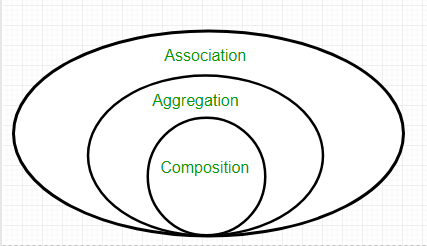
Association
Association is the cardinal concept in object-oriented programming that describes the relationship between two independent classes. Association can be viewed as describing a “uses-a” relationship where an object uses, or in any way interacts with, another object. Association may be either unidirectional or bidirectional and may exist in several forms, such as one-to-one, one-to-many, many-to-one, and many-to-many.
Type of Association
Unidirectional Association:
This association is the one in which one class is aware and associated with another class; the reverse is not true. For example, the Student class can be associated with the LibraryCard class, for the association where the student has a library card; a LibraryCard does not need to ‘know about’ a Student.
Bidirectional Association:
In this type of association, the classes are aware of each other and interact with one another. For example, a Teacher class and a Classroom class may be associated bidirectionally; there would be a teacher assigned to a classroom, and a classroom would know to which teacher it is assigned.
Association Example:
Java
// Java Program to illustrate the
// Concept of Association
// Importing required classes
import java.io.*;
import java.util.*;
// Class 1
// Bank class
class Bank {
// Attributes of bank
private String bankName;
private Set<Employee> employees;
// Constructor of Bank class
public Bank(String bankName)
{
this.bankName = bankName;
}
// Method of Bank class
public String getBankName()
{
// Returning name of bank
return this.bankName;
}
public void setEmployees(Set<Employee> employees)
{
this.employees = employees;
}
public Set<Employee> getEmployees()
{
return this.employees;
}
}
// Class 2
// Employee class
class Employee {
// Attributes of employee
private String name;
// Constructor of Employee class
public Employee(String name)
{
// this keyword refers to current instance
this.name = name;
}
// Method of Employee class
public String getEmployeeName()
{
// returning the name of employee
return this.name;
}
}
// Class 3
// Association between both the
// classes in main method
class AssociationExample {
// Main driver method
public static void main(String[] args)
{
// Creating Employee objects
Employee emp1 = new Employee("Ridhi");
Employee emp2 = new Employee("Vijay");
// adding the employees to a set
Set<Employee> employees = new HashSet<>();
employees.add(emp1);
employees.add(emp2);
// Creating a Bank object
Bank bank = new Bank("ICICI");
// setting the employees for the Bank object
bank.setEmployees(employees);
// traversing and displaying the bank employees
for (Employee emp : bank.getEmployees()) {
System.out.println(emp.getEmployeeName()
+ " belongs to bank "
+ bank.getBankName());
}
}
}
OutputRidhi belongs to bank ICICI
Vijay belongs to bank ICICI
Explanation of the above Program:
In the above example, two separate classes Bank and Employee are associated through their Objects. Bank can have many employees, So, it is a one-to-many relationship.
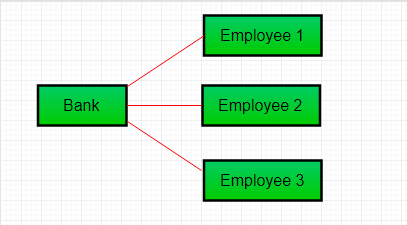
Aggregation
Aggregation is a relationship that comes under object-oriented programming, classifying an instance of a class as “has a.” It’s a form of association with weaker relationship strength, whereby the lifetime of the contained object (part) is not controlled based on the lifetime of the container object (whole). Concepts of aggregation are quite important for developing modular and reusable software components.
Aggregation is a type of association that represents a relationship where one class is a collection or container of another class. It depicts a “has-a” relationship, where the container object can exist independently of its contents, and the contained objects can exist independently of the container.
It is a special form of Association where:
- It represents Has-A’s relationship.
- It is a unidirectional association i.e. a one-way relationship. For example, a department can have students but vice versa is not possible and thus unidirectional in nature.
- In Aggregation, both entries can survive individually which means ending one entity will not affect the other entity.
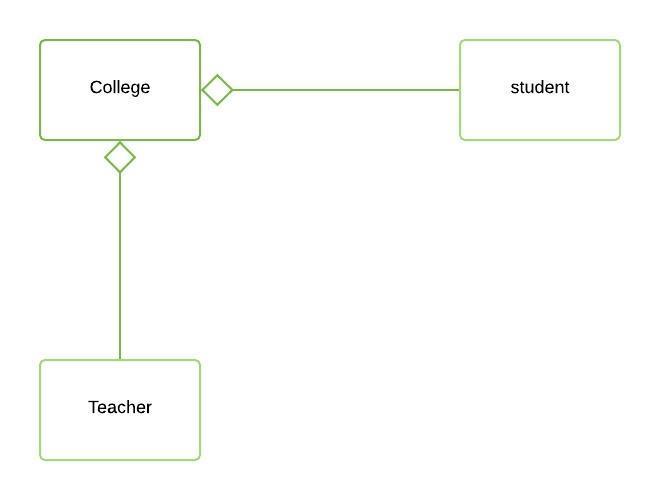
Aggregation Example:
Java
// Java program to illustrate
// Concept of Aggregation
// Importing required classes
import java.io.*;
import java.util.*;
// Class 1
// Student class
class Student {
// Attributes of Student
private String studentName;
private int studentId;
// Constructor of Student class
public Student(String studentName, int studentId)
{
this.studentName = studentName;
this.studentId = studentId;
}
public int getstudentId() {
return studentId;
}
public String getstudentName() {
return studentName;
}
}
// Class 2
// Department class
// Department class contains list of Students
class Department {
// Attributes of Department class
private String deptName;
private List<Student> students;
// Constructor of Department class
public Department(String deptName, List<Student> students)
{
this.deptName = deptName;
this.students = students;
}
public List<Student> getStudents() {
return students;
}
public void addStudent(Student student)
{
students.add(student);
}
}
// Class 3
// Institute class
// Institute class contains the list of Departments
class Institute {
// Attributes of Institute
private String instituteName;
private List<Department> departments;
// Constructor of Institute class
public Institute(String instituteName,
List<Department> departments)
{
// This keyword refers to current instance itself
this.instituteName = instituteName;
this.departments = departments;
}
public void addDepartment(Department department)
{
departments.add(department);
}
// Method of Institute class
// Counting total students in the institute
public int getTotalStudentsInInstitute()
{
int noOfStudents = 0;
List<Student> students = null;
for (Department dept : departments) {
students = dept.getStudents();
for (Student s : students) {
noOfStudents++;
}
}
return noOfStudents;
}
}
// Class 4
// main class
class AggregationExample {
// main driver method
public static void main(String[] args)
{
// Creating independent Student objects
Student s1 = new Student("Parul", 1);
Student s2 = new Student("Sachin", 2);
Student s3 = new Student("Priya", 1);
Student s4 = new Student("Rahul", 2);
// Creating an list of CSE Students
List<Student> cse_students = new ArrayList<Student>();
cse_students.add(s1);
cse_students.add(s2);
// Creating an initial list of EE Students
List<Student> ee_students = new ArrayList<Student>();
ee_students.add(s3);
ee_students.add(s4);
// Creating Department object with a Students list
// using Aggregation (Department "has" students)
Department CSE = new Department("CSE", cse_students);
Department EE = new Department("EE", ee_students);
// Creating an initial list of Departments
List<Department> departments = new ArrayList<Department>();
departments.add(CSE);
departments.add(EE);
// Creating an Institute object with Departments list
// using Aggregation (Institute "has" Departments)
Institute institute = new Institute("BITS", departments);
// Display message for better readability
System.out.print("Total students in institute: ");
// Calling method to get total number of students
// in the institute and printing on console
System.out.print(
institute.getTotalStudentsInInstitute());
}
}
OutputTotal students in institute: 4
Explanation of the above Program:
In this example,
- There is an Institute which has no. of departments like CSE, EE. Every department has no. of students.
- So, we make an Institute class that has a reference to Object or no. of Objects (i.e. List of Objects) of the Department class.
- That means Institute class is associated with Department class through its Object(s).
- And Department class has also a reference to Object or Objects (i.e. List of Objects) of the Student class means it is associated with the Student class through its Object(s).
It represents a Has-A relationship. In the above example: Student Has-A name. Student Has-A ID. Department Has-A Students as depicted from the below media.
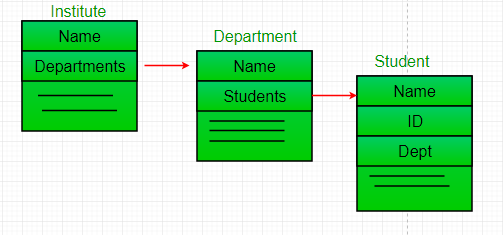
Note: Code reuse is best achieved by aggregation.
Composition
Composition is a core concept in object-oriented programming that refers to the relationship “part-of” between classes. It is a stronger form of association in which the contained objects’ lifecycle is strongly associated with the container object’s lifecycle. The understanding of composition is crucial in the design of complex systems where objects of the system are composed of other objects.
Composition is a type of association meaning one class “contains” another. This association can be said to be a “part-of” relationship and would denote that the contained object is strongly connected with the containing object, the whole. The parts cannot be without the whole.
Composition is a restricted form of Aggregation in which two entities are highly dependent on each other.
- It represents part-of relationship.
- In composition, both entities are dependent on each other.
- When there is a composition between two entities, the composed object cannot exist without the other entity.
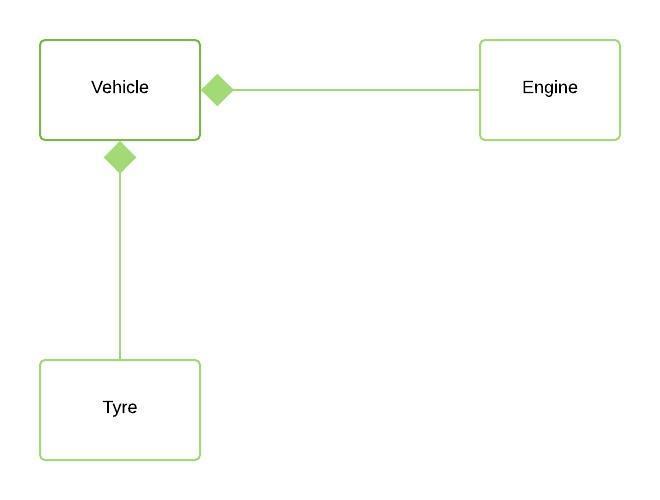
Composition Example:
Java
// Java program to illustrate
// Concept of Composition
// Importing required classes
import java.io.*;
import java.util.*;
// Class 1
// Department class
class Department {
// Attributes of Department
public String departmentName;
// Constructor of Department class
public Department(String departmentName)
{
this.departmentName = departmentName;
}
public String getDepartmentName()
{
return departmentName;
}
}
// Class 2
// Company class
class Company {
// Reference to refer to list of books
private String companyName;
private List<Department> departments;
// Constructor of Company class
public Company(String companyName)
{
this.companyName = companyName;
this.departments = new ArrayList<Department>();
}
// Method
// to add new Department to the Company
public void addDepartment(Department department)
{
departments.add(department);
}
public List<Department> getDepartments()
{
return new ArrayList<>(departments);
}
// Method
// to get total number of Departments in the Company
public int getTotalDepartments()
{
return departments.size();
}
}
// Class 3
// Main class
class CompositonExample {
// Main driver method
public static void main(String[] args)
{
// Creating a Company object
Company techCompany = new Company("Tech Corp");
techCompany.addDepartment(new Department("Engineering"));
techCompany.addDepartment(new Department("Operations"));
techCompany.addDepartment(new Department("Human Resources"));
techCompany.addDepartment(new Department("Finance"));
int d = techCompany.getTotalDepartments();
System.out.println("Total Departments: " + d);
System.out.println("Department names: ");
for (Department dept : techCompany.getDepartments()) {
System.out.println("- " + dept.getDepartmentName());
}
}
}
OutputTotal Departments: 4
Department names:
- Engineering
- Operations
- Human Resources
- Finance
Explanation of the above Program:
In the above example,
- A company can have no. of departments.
- All the departments are part-of the Company.
- So, if the Company gets destroyed then all the Departments within that particular Company will be destroyed, i.e. Departments can not exist independently without the Company.
- That’s why it is composition. Department is Part-of Company.
Difference Between Association, Aggregation and Composition
Feature | Association | Aggregation | Composition |
|---|
Definition
| General relationship between two classes
| A special form of association with a “has-a” relationship
| A stronger form of association with a “part-of” relationship
|
|---|
Dependency
| Classes are related but can exist independently
| Contained objects can exist independently of the container object
| Contained objects cannot exist without the container object
|
|---|
Lifecycle
| Independent lifecycles
| Independent lifecycles
| Dependent lifecycles
|
|---|
Ownership
| No ownership implied
| Shared ownership
| Exclusive ownership
|
|---|
Strength
| Weak
| Moderate
| Strong
|
|---|
Cardinality
| One-to-one, one-to-many, many-to-one, many-to-many
| One-to-one, one-to-many, many-to-one, many-to-many
| One-to-one, one-to-many
|
|---|
Example
| Teacher and Student
| Library and Books
| Car and Engine
|
|---|
Representation
| Uses a direct reference
| Uses a reference to the contained object(s)
| Contains instances of the contained object(s)
|
|---|
Illustrative Example Code
| java class
Teacher { private
Student student;
}
| java class
Library { private
List<Book> books;
}
| java class
Car { private
Engine engine;
}
|
|---|
Please Login to comment...